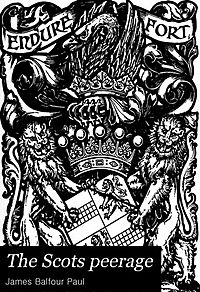The Scots Peerage facts for kids
 |
|
|
|
|
| Edited by | Sir James Balfour Paul |
|---|---|
| Original title | The Scots Peerage: Founded on Wood's Edition of Sir Robert Douglas's Peerage of Scotland, containing an Historical and Genealogical Account of the Nobility of that Kingdom |
| Illustrator | Graham Johnston |
| Country | Scotland |
| Language | English |
| Genre | Nobility, heraldry, genealogy |
| Publisher | David Douglas |
| No. of books | 9 (eight volumes + index) |
The Scots Peerage is a big set of nine books about the Scottish nobility. It was put together by Sir James Balfour Paul and published in Edinburgh between 1904 and 1914. The full name of the series is The Scots Peerage: Founded on Wood's Edition of Sir Robert Douglas's Peerage of Scotland, containing an Historical and Genealogical Account of the Nobility of that Kingdom.
Contents
About The Scots Peerage
This book series starts with the Kings of Scotland. It tells the complete story of Scottish noble families. This includes titles that still exist today and those that have ended.
The books also show pictures and descriptions of each family's heraldic achievement. This means their arms, crest, supporters, and family mottos. Each part was written by someone who knew a lot about that specific topic.
Earlier Books on Scottish Nobility
Before The Scots Peerage, there was a book by Sir Robert Douglas. In 1764, he published The Peerage of Scotland. He was working on a second book, but he passed away in 1770.
Other editors finished his second book. It was published in 1798 as Baronage of Scotland. A new version of Douglas's work came out in 1813. This was edited by John Philip Wood. However, it had some mistakes from both Douglas and Wood.
Why a New Book Was Needed
Sir James Balfour Paul was a very important person in Scottish heraldry. He was the Lord Lyon King of Arms from 1890 to 1926. He believed a new, official book on Scottish nobility was needed.
The book is dedicated to Sir William Fraser. He left money in his will to print books that would help explain Scotland's history.
In the first book, Paul wrote about the earlier works by Douglas and Wood. He said they were good for their time. Douglas could easily get information from noble families. Many of their old family papers were shared with him.
However, Paul explained that Douglas and Wood lived when historical records were harder to find. Most records were not printed or organized well. This meant that while their information about their own time was good, details from older centuries were often incomplete or wrong.
The Importance of The Scots Peerage
The Oxford Dictionary of National Biography said that The Scots Peerage was Sir James Balfour Paul's most important work. It was lucky that such a huge project was finished just before World War I started.
This book replaced all older Scottish peerage books. It was very complete and accurate. Unlike some other peerage books, it included more than just the main heirs to titles. Paul had a lot of help from many smart people. But everyone agrees that he was the one who inspired the whole project and deserves most of the credit.
Volumes of The Scots Peerage
The Scots Peerage is now in the public domain. This means anyone can use it freely. You can find all its volumes online at the Internet Archive.
| Volume | Date | From | To | Pages |
|---|---|---|---|---|
| 1904 | Kings of Scotland; Earl of Abercorn | Lord Balmerino | 575 | |
| 1905 | Lord Banff | Lord Cranstoun | 602 | |
| 1906 | Earl of Crawford | Viscount Falkland | 617 | |
| 1907 | Earl of Fife | Earl of Hyndford | 597 | |
| 1908 | Lord Innermeath | Earl of Mar | 639 | |
| 1909 | Earl of Marchmont | Viscount of Oxfuird | 601 | |
| 1910 | Earl of Panmure | Lord Sinclair | 502 | |
| 1911 | Lord Somerville | Earl of Winton | 605 | |
| 1914 | Index and corrections | 913 |
Coats of Arms Gallery
The pictures in the books were drawn by Graham Johnston. He was the official herald-painter for the Lord Lyon from 1898 to 1927. The drawings in the first two books were simple and bold. But in the third book, the style changed to a more traditional look.
-
Arms of the Earl of Dalhousie
-
Arms of the Lord Doune
-
Arms of the Earl of Dundonald
-
Arms of the Earl of Mar and Kellie
-
Arms of the Earl of Eglinton and Winton
-
Arms of the Lord Banff
-
Arms of the Earl of Glasgow
-
Arms of the Earl of Kinnoull
-
Arms of the Viscount Stormont
-
Arms of the Earl of Carnwath
-
Arms of the Earl of Southesk
-
Arms of the Earl of Strathmore and Kinghorne
-
Arms of the Lord Elibank
-
Arms of the Lord Sempill
-
Arms of the Earl of Erroll
















